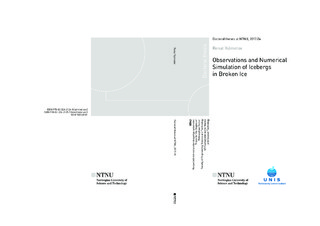| dc.description.abstract | Sea ice and icebergs are the major challenges for offshore activities in the Arctic. Design
loads for Arctic offshore structures may be significantly reduced if the drift of sea ice
and icebergs is possible to forecast accurately and perform physical ice management
when required. So far, this has been successfully done solely for sea ice or solely for
icebergs drifting in open water. There is a lack of knowledge about icebergs drifting
together with broken ice, and there is no operational experience of deflecting an iceberg
in broken ice.
An iceberg moving relatively sea ice should experience additional resistance force,
which in general grows as the ice thickness, relative velocity or the ice concentration
increase. It complicates the drift forecasting and potentially threatens iceberg towing
operations in sea ice. This resistance force is hard to estimate: there are only a few
analytical equations, and there is only one model-scale experiment of iceberg towing in
ice. Published information about full-scale trials of towing is almost absent. However,
numerical methods, that have been used to model floaters and ships in broken ice, are
possible to utilize for the modelling of icebergs in broken ice.
This thesis covers observations, tracking and forecasting of icebergs and sea ice in the
Greenland Sea and in the Barents Sea, and numerical modelling of iceberg towing in
broken ice. The tracking has been performed using GPS that provided high temporal
and spatial resolution of the drift trajectories. Statistical data on drift velocities, spectra,
trajectory curvatures are derived. In addition, the relative drift velocity between the
sea ice and icebergs is obtained. Characteristic values and observations are used for
the numerical modelling part. Finally, for the first time, the yawing of real icebergs is
measured and simulated. These data can be used for the design of offshore structures
or when planning offshore operations, especially the ice management.
The numerical modelling of iceberg towing in ice is performed using the non-smooth
discrete element method. A number of important knowledge gaps in material
description and in the numerical method are filled. First of all, it is demonstrated that
the collisions of floating ice floes are almost inelastic, resulting in restitution coefficient
values close to zero. Second, the characteristic feature of the method is a solution
calculated in the form of contact impulses between the bodies, which makes it hard to
estimate the contact forces. A conversion method between the contact impulses and
the contact forces is proposed based on the experiments on a wide range of scales.
Also, a potential flow is introduced in the vicinity of the simulated iceberg leading
to better ice flow representation. Finally, an algorithm generating broken ice fields
for the simulations is developed. The algorithm produces numerical ice fields having
natural ice floe size distribution and target ice concentration.
In the situation when available relevant data are extremely limited, a validation
study is performed on a model-scale experiment in broken ice. The numerical model
reproduces the average towing force magnitude measured in the experiment and the
motion of ice when the ice concentration is below 80%. In addition, the ice resistance
obtained numerically is compared to existing analytical estimates of ice resistance to
drifting icebergs. The estimates appear to give much lower ice resistance mainly due
to no mechanical confinement during the drift.
The numerical model can be further developed in a number of ways: ice floe failure in
different modes might be introduced, the model of iceberg in ice can be coupled with
a ship model, validation against full-scale trials can be performed after they happen,
etc. On the current stage, the model can be used as a numerical towing tank or as an
aid for planning the first towing operations in the broken ice. | nb_NO |
